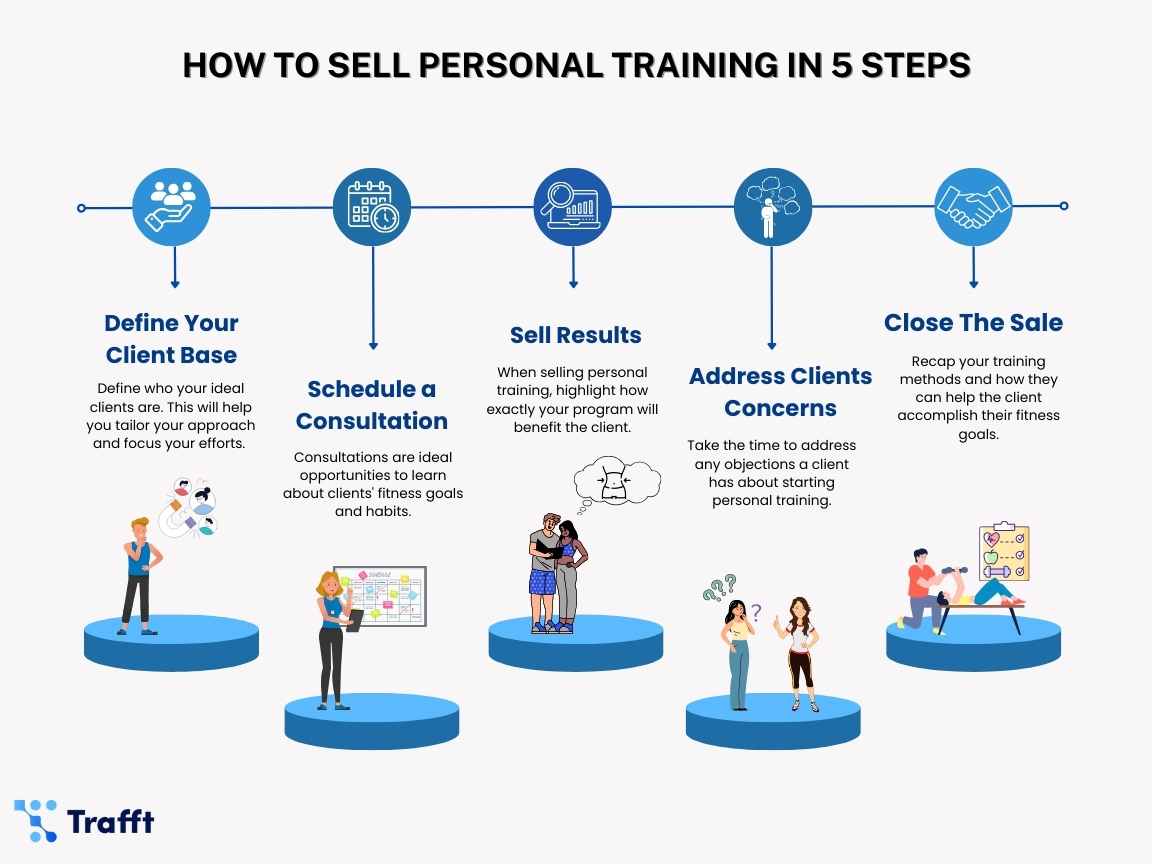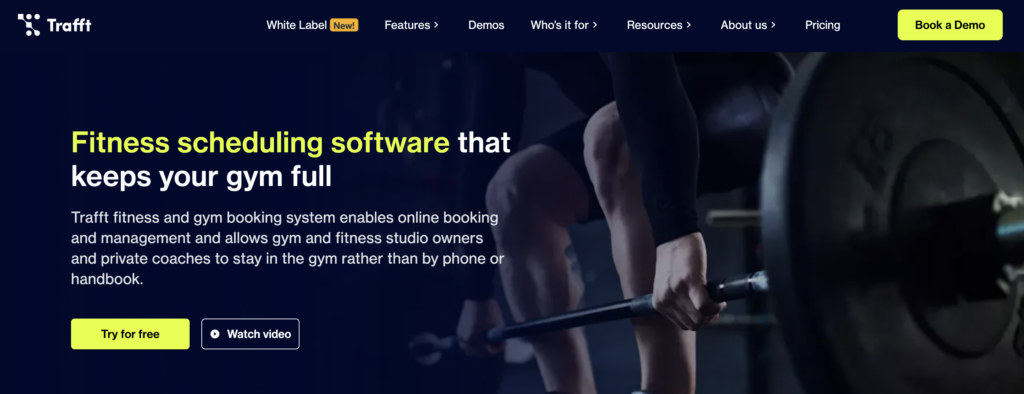As all personal trainers know, a good exercise routine takes consistency. The same is true when coming up with a plan on how to sell personal training packages to clients.
Personal trainers need to be consistent in their efforts to attract new clientele and sell their services.
But how do you start the sales process without boring your potential client? Start by striking up a conversation. This might be the beginning of your trainer-client relationship, so make sure you pay attention to what they’re saying.
However, just having a casual conversation isn’t enough to secure a sale. Many desirable skills and a few tactics can make you much more successful in your efforts.
In this guide on how to sell personal training, we will go through some simple steps that lead to success. Whether you prefer teaching in-person or online, these strategies will help you effectively market your services and attract potential clients.

1. Define Your Client Base
The end goal is to sell your service, right? But that’s a bit broad and not helpful when you are trying to put together your action plan.
Understanding your client base is crucial when developing a strategy on how to sell personal training sessions. After all, you can’t effectively market to everyone. So, who exactly are you targeting? Defining your ideal client helps tailor your approach and ensures your efforts are focused and effective.
Do you want to work with individuals who want to improve their health or athletes looking to enhance their performance? Additionally, you can choose to work with elderly people or those with special health concerns.
This doesn’t mean you need to choose just one category and limit your client base too much; rather, it should give you some guidance as to whom you want to attract primarily.
Find the perfect client
Think about who the prospective clients are, what interests them, and what places they go. Visit these places to find more potential clients. The internet has provided a new and effective way to start a conversation with many people. Try utilizing it to get in contact with your ideal audience.
Thinking about prospective clients also helps to prepare for any questions they may have. It would be good if you can give an answer to most of these:
- Who is interested in my service?
- Where do they spend their time?
- What are their hobbies?
- What are their challenges and obstacles?
- What motivates them?
- What prevents them from exercising?
- What kind of help do they need?
- How can I make a difference in their life?
When personal trainers focus on building relationships, they have more success. Clients need to trust their coaches and feel like they care about them.
The first step in the sales process is to start a conversation, and the end goal is to have a good relationship with the client. But what are the steps in between?
2. Schedule a Consultation
The next step in our guide on how to sell personal training packages is getting a consultation with a potential customer. Most personal trainers start a conversation by offering a free training session. Or they provide free advice to potential clients.
This is a great method for expanding your client base. However, it can be a challenge to steer the conversation toward making a purchase.
To overcome this, focus on understanding the client’s needs and goals during the consultation. Ask open-ended questions to uncover their fitness preferences and daily habits. The end goal is to show them how easy it is to implement fitness in their everyday life. Listen actively and offer personalized solutions tailored to their specific needs.
Don’t avoid mentioning your deals
Many personal trainers are afraid to discuss their training packages because doing so can scare clients away. However, the opposite is true.
Take the time to present your offerings properly. This will also help you differentiate between people who have a genuine interest in your services and those who are just browsing around. After that, you can focus your energy on the people who are most likely to convert into paying customers.
It still might feel awkward to steer the consultation toward a purchase, but don’t hesitate. One way to make this transition easier is to provide a summary of the consultation process.
Whether it’s by phone, in person, or online, explain how it works. Mention that you will answer all the client’s questions, craft an individual program tailored to their needs, and lastly, discuss various personal training packages briefly. This way, when the time comes, talking about purchasing options will feel less awkward.
3. Sell Results

Potential clients reach out to personal trainers because they are seeking a solution. They are often distressed and struggling with an exercise routine. But when you come into the picture, don’t just list the number of training sessions and services included.
When selling personal training, highlight how exactly your program will benefit the client. People tend to buy based on emotion. So, personal trainers need to understand the emotional factors behind a person’s goals. Emotions drive actions but they also play a crucial part in motivation. Tap into this field so you can inspire your clients to make the change.
Outline a routine
While discussing the client’s needs, write down the most important ones so they can see you already have a plan to help them. The outline does not have to be perfect, but it’s there to show you are taking everything into account.
Here is some advice for creating a perfect routine your client will stick with:
- Review what their fitness journey looked like up until this point. Let the client take the lead in the discussion. Do not talk too much.
- Give them enough information to demonstrate your expertise and promote your personal training services. But do not lose their interest by over-talking.
- Discuss steps to deal with specific challenges. For example, propose a plan to help them if they have knee pain or shoulder pain.
- Give a solution for common issues. For example, talk about overcoming muscle soreness or other obstacles.
Ask the right questions

During the initial consultation, we are sure your clients will have some questions. It’s a no-brainer that you should answer them, but don’t forget to ask a few as well.
Asking questions accomplishes several goals. First, it shows personal interest in the clients. Second, trainers get to know clients better and can offer services that they are more likely to say yes to.
This also gives you an opportunity to learn about their challenges, goals, and any sensitive issues. If a potential client is not talkative, take advantage of awkward silences to get them to open up.
The most important thing personal trainers can do at this stage is to listen. Listen carefully to what the potential client says and remember it. Then, adapt to their individual needs and convert them into paying customers.
These questions can help get a conversation going:
- What made you decide to check out personal training options?
- Do you have experience working with a personal trainer?
- What made you stop going to a personal trainer?
- Why have you put off personal training until now?
- What are your fitness goals?
- Why are those goals important to you?
- What is your exercise history?
4. Address Clients Concerns
When you look at the typical salesperson, what do they often encounter? Objections. People always try to find the reason why they shouldn’t buy something. So, in order to learn how to sell personal training, you also need to learn how to handle these objections.
Almost every potential client will have something to say about why now isn’t a perfect time to start with personal training sessions. So, coaches need to understand the reasons why a sale has not moved forward. They must address them and guide clients towards committing to their fitness journey.
Some objections are sincere, and others are a way to stall. That’s why you need to determine a person’s level of interest. To do so, take the initiative and ask questions about the proposed plan.
Check if they have any more questions and what obstacles they foresee. Common objections are:
- I do not have enough time
- I do not need your services
- I need to talk to my spouse
- It is too expensive
Prepare responses to these and other common objections for your chosen demographic. Try to write a few talking points as to how you can answer these arguments because you will hear them quite a lot.
Introduce pricing plans

Price should be the last objection a personal trainer addresses. Put off answering questions about the price until clients have seen the value of your services.
Give them a taste of what you offer. People are more likely to pay for such services after getting a feel of your methods and personality.
When it comes time to discuss prices, personal trainers have two options. The first option is to present one flat pricing plan. With this option, try to compare the price of the services with something else to put it into perspective. For example, if the charge is $300 for a month of personal training, point out that the client is paying ten dollars a day. By offering a price comparison in this way, the cost seems more affordable to the client.
The second option is to present more than one pricing plan. This helps clients feel in control and increases the odds that they will sign up. If you are using this method, present at least three but no more than five pricing plans. Each pricing plan should also offer more services.
Why have at least three pricing plans? With three pricing plans, it’s possible to make one look like a better value compared to the others.
The first plan should offer basic services and be inexpensive. The second plan should offer more advantages at a steeper price tag. The third plan should have extensive services at a more expensive price. Keep in mind that this strategy makes people choose the middle option most of the time. The third plan will provide a reference point that makes the second plan look like good value. So, clients are more likely to choose the second plan, and it makes them feel they are getting good value for their money.
Do not offer more than five pricing plans, as this would be overwhelming. Make sure each pricing plan clearly presents its benefits and perks.
5. Close The Sale
The last step in our how to sell personal training guide is to close the sale. Sales are often lost because personal trainers are too timid to get things done.
Simply ask the client, “Do you have any more concerns? Are you ready to sign up for a program?” Don’t be discouraged if they have more objections or say no to purchasing a plan. As many personal trainers say to their clients, do not give up.
One effective closing method is to remind the client of what they said about their fitness goals. Recap your personal training methods and how they can help your clients accomplish them. This will often be enough to change that no into let’s give it a try!
Elevate Your Fitness Business with Trafft
Looking for a way to optimize your fitness business operations and boost client engagement? Meet Trafft, the all-in-one solution designed to revolutionize how you manage your personal training sessions.
Trafft isn’t just another scheduling tool—it’s your partner in success. With its intuitive interface, calendar synchronization, and Zoon and Google Meet integration, juggling in-person and online training sessions has never been easier.
Create your booking page in just a few minutes and let your clients schedule a session at their convenience. No more interruptions and endless phone calls so you can just focus on your current client and their needs.
Worried about clients missing their appointments? Use Trafft’s automated reminder feature to make sure they show up every time. Just choose a channel, such as Email, SMS, or WhatsApp, and let Trafft handle the rest.
Not yet convinced? Take a look at Trafft’s features and see what you are missing. Even better, sign up for free and experience efficiency firsthand!
Ending Thoughts on How to Sell Personal Training
Selling personal training can be challenging, but you don’t need to be a master salesman to do it properly. A personal trainer’s role in the sales process is to ask questions, listen, and explain their training methods.
Prepare talking points ahead of time to overcome objections and describe the process. Make sure to show personal attention to each potential client. People appreciate it and will choose a trainer who cares about them.
Remember to talk about the price after they have a taste of the value of your services. Do not be afraid to ask for the sale after going through the sales pitch.
If you really believe in what you are selling, there is no reason to be nervous. Trainers who are confident in what they are offering will have no problem making new clients.
And if you ever need a refresher, just revisit this guide on how to sell personal training.
FAQs About Selling Personal Training Services
1. How much should I charge for my personal training services?
It can be difficult to estimate the right cost for personal training services. Your experience, location, and skill demand can all affect pricing. Market research is imperative to determine the usual market rate for personal training services in your location.
After that, you should consider your credentials and expertise. When calculating your price, you should also account for any additional charges, such as gym rental fees or equipment costs.
2. What kind of training programs should I offer to my clients?
Your training programs for clients should be customized to meet their unique needs and objectives. While some clients might prefer to concentrate on strength training, others could be more concerned with losing weight or enhancing their cardiovascular health.
As a personal trainer, you should be thoroughly aware of the various training methods and be able to create tough yet efficient workout routines. To keep your clients interested and motivated, consider including a range of exercises and training techniques in your programs.
3. How do I market my personal training services effectively?
Although it can be difficult, marketing your personal training services is crucial for growing your clientele. Make use of social media channels like Facebook and Instagram to promote your skills and produce interesting material. Another effective marketing tactic is to network with other experts in your field, such as dietitians or physical therapists. You can also expand your clientele by offering new customers free trial sessions or discounts.
4. How do I handle client cancellations or no-shows?
Having a clear appointment cancellation policy and communicating it to your clients is vital to reduce the impact of cancellations or no-shows.
To discourage last-minute cancellations, think about establishing a cancellation fee and rescheduling policies that permit customers to do so without incurring a fee up to a certain amount of time in advance. Also, you should get in touch with clients who miss sessions to find out why they missed them and make sure they continue with their training.
5. How do I keep my clients motivated to continue training?
The key to your client’s success and retention is keeping them motivated. One method is to offer regular feedback and encouragement. Clients can observe their success by setting realistic goals and keeping track of them, which can be a strong motivator.
Consider occasionally changing up their training schedules to keep things exciting and novel.
6. What certifications do I need to become a personal trainer?
Depending on the nation and location, there are many personal trainer certifications you will likely need. In the United States, the National Academy of Sports Medicine (NASM), American Council on Exercise (ACE), and International Sports Sciences Association (ISSA) are among the most respected certification bodies.
Certification in CPR and First Aid is also frequently necessary. It’s crucial to do your homework and pick a credible certification program that suits your professional aspirations.
7. How do I determine a client’s fitness level and create a personalized workout plan?
To develop a customized workout regimen, it is essential to evaluate a client’s fitness level. To check their baseline fitness level, think about utilizing standardized fitness tests like the push-up or squat test as well as questionnaires about usual workout habits.
It’s crucial to comprehend their lifestyle, fitness aspirations, and any existing medical issues or injuries. From there, you can create a customized exercise program that considers their unique needs and objectives and may include cardio, strength, or flexibility training.
8. How do I handle difficult clients who may be resistant to my recommendations?
Although managing tough clients can be quite challenging, retaining professionalism and ensuring they get the greatest service is crucial. Pay attention to their worries and comprehend their viewpoint.
Also, you must share your knowledge and outline how your suggestions might assist them in achieving their goals. Ultimately, it’s up to the client to decide whether to accept your advice, but by giving evidence-based ideas, you may build trust and establish a constructive working relationship.
9. Should I offer virtual personal training services, and how do I deliver them effectively?
By providing virtual personal training services, you may increase your clientele and give both you and your clients more freedom. You must have the right infrastructure and technology to properly deliver online training. A quality camera, microphone, and a reputable video conferencing platform should all be taken into consideration.
You should also ensure that your clients have access to the required equipment and space to execute exercises safely and successfully.
10. What legal considerations should I be aware of when selling personal training services, such as liability and insurance?
As a personal trainer, any mishaps or injuries that occur during training sessions could put you at risk. In the event of an accident or property damage, liability insurance that protects both you and your clients is crucial.
Before starting training, you should also have clients sign a waiver and release of liability, which describes the possible dangers and accepts that they are responsible for any injuries that may arise. Familiarizing yourself with any local laws or regulations about personal training, such as registration or certification requirements, is also necessary.




